Enjoying the Local Sites ~Part 3~
Canada 10-29-2019 thru 10-30-2019
Living in Washington State comes with the advantage of obtaining an enhanced driver’s license, which costs only slightly more than the standard one. The enhanced license offers the convenience of crossing both the Canadian/US and Mexico/US borders. Additionally, it fulfills the requirements for air travel, making it a practical choice for residents near the Canadian border.
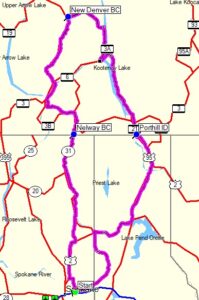 When my sister moved here, as she prepared to obtain her WA driver’s license, I inquired whether she had ever been to Canada. She responded that she had not. Considering Canada was just around 100 miles from our home, we decided to rectify that. I informed her about the enhanced driver’s license, guided her on the requirements, and together we headed to the Department of Licensing. Within about a week, her new license arrived, and we promptly made plans for a road trip into Canada.
When my sister moved here, as she prepared to obtain her WA driver’s license, I inquired whether she had ever been to Canada. She responded that she had not. Considering Canada was just around 100 miles from our home, we decided to rectify that. I informed her about the enhanced driver’s license, guided her on the requirements, and together we headed to the Department of Licensing. Within about a week, her new license arrived, and we promptly made plans for a road trip into Canada.
We loaded our overnight bags into the van and embarked on a journey into Canada for my sister’s first visit. Our route followed a segment of the Selkirk Loop and included a ferry ride—an experience my sister had yet to enjoy.
British Columbia, Canada



As we crossed the border into Canada, we were greeted by awe-inspiring scenery that, at times, was almost overwhelming in its beauty. Amidst the breathtaking views, the delight of traveling with my sister added an extra layer of pleasure to my experience.
Heading north on 3A, we soaked in the stunning scenery. Our travels took us to Crescent Valley, and from there, we continued on Highway 6, eventually reaching the southern shores of Slocan Lake. Following the road along the lake’s eastern shore, we finally reached our destination for the day – New Denver, BC.
Even though I had visited British Columbia on several occasions and even visited the west side of Slocan Lake, New Denver was a new experience. I had heard about the exceptional 31A route, spanning between New Denver and Kaslo, BC – a 45-mile stretch offering breathtaking views – intrigued me. Opting to save this scenic road for the next day, we decided to spend the night in New Denver, anticipating the adventure that awaited us.
 As we were driving into town we saw a sign for a reflection garden and since there was still plenty of daylight left after checking into the motel we returned to the garden to explore what it had to offer.
As we were driving into town we saw a sign for a reflection garden and since there was still plenty of daylight left after checking into the motel we returned to the garden to explore what it had to offer.
Upon returning to the garden, we found out that the name is Kohan Reflection Garden. This Japanese-style garden was established back in 1989. The grounds hold significance as they pay tribute to the Japanese Canadians who were relocated to BC and placed in the New Denver internment camp in 1942 during World War II.
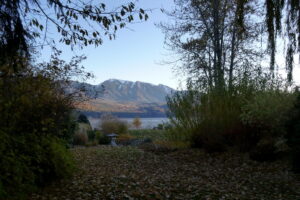 We strolled through the gardens, savoring the tranquil atmosphere. Although the pools and streams were empty at that time of year, the garden, situated on the shores of Slocan Lake, offered a serene experience.
We strolled through the gardens, savoring the tranquil atmosphere. Although the pools and streams were empty at that time of year, the garden, situated on the shores of Slocan Lake, offered a serene experience.
Inside the garden, an abundance of trees and plants adorned the surroundings. Japanese flowering cherry trees and Japanese Maple are throughout the garden, creating a delightful ambiance. Our stroll also led us to appreciate various Japanese fixtures, such as:
 Ishi-doro Stone Lantern: In a Japanese garden, besides providing light for a turn in a path, a lantern also lends light to spiritual darkness.
Ishi-doro Stone Lantern: In a Japanese garden, besides providing light for a turn in a path, a lantern also lends light to spiritual darkness.
Tsukubai: An arrangement of stones, plants, and a chōzubachi basin where, as an act of humility and spiritual cleansing, one bends to wash before entering the Teahouse.
The Tsurigane: A ceremonial bell just inside the Entrance Gate.
Teahouse:
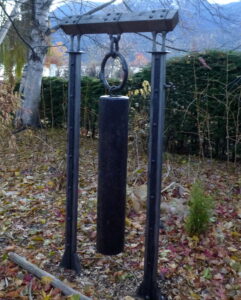
Built as an outdoor meeting place by the Japanese-Canadian community for Ceremonial purposes.
There are numerous things I didn’t pick up in school, but my travels have been a source of valuable education. In 2005, during a motorcycle ride to Death Valley, I discovered that the United States had interned Japanese Americans. Learning this history left me shocked and horrified that such a thing had occurred to our own citizens. Exploring the remnants of that camp and delving into its history, I came to see that an internment camp was essentially a different name for a prison camp.
While I had learned about internment camps in the United States, I was unaware that similar camps existed in Canada. It reinforces my appreciation for taking the time to explore and learn during my travels. I do acknowledge that at times, I come across information that is difficult to accept.
New Denver is home to The Nikkei Internment Memorial Centre (NIMC), recognized as a National Historic Site. This site is committed to telling the story of more than 22,000 Japanese Canadians who were forcibly relocated during World War II. Although we didn’t explore this site during our visit, I plan to return and dedicate time to learning more about it.
After visiting the gardens we went to dinner and called it a night. I drifted off to sleep thinking about what I had seen and looking forward to what we would see the next day.
Moving On . . .



As I had been told, Highway 31A between New Denver and Kaslo proved to be incredibly scenic and enjoyable. I look forward to returning for a motorcycle ride along that route. During our journey, we discovered a pull-off at the mountain’s summit, providing a perfect spot to pause and absorb the breathtaking views. With the cold weather, I had a slight concern about the road getting slippery, but fortunately, it didn’t pose any issues.

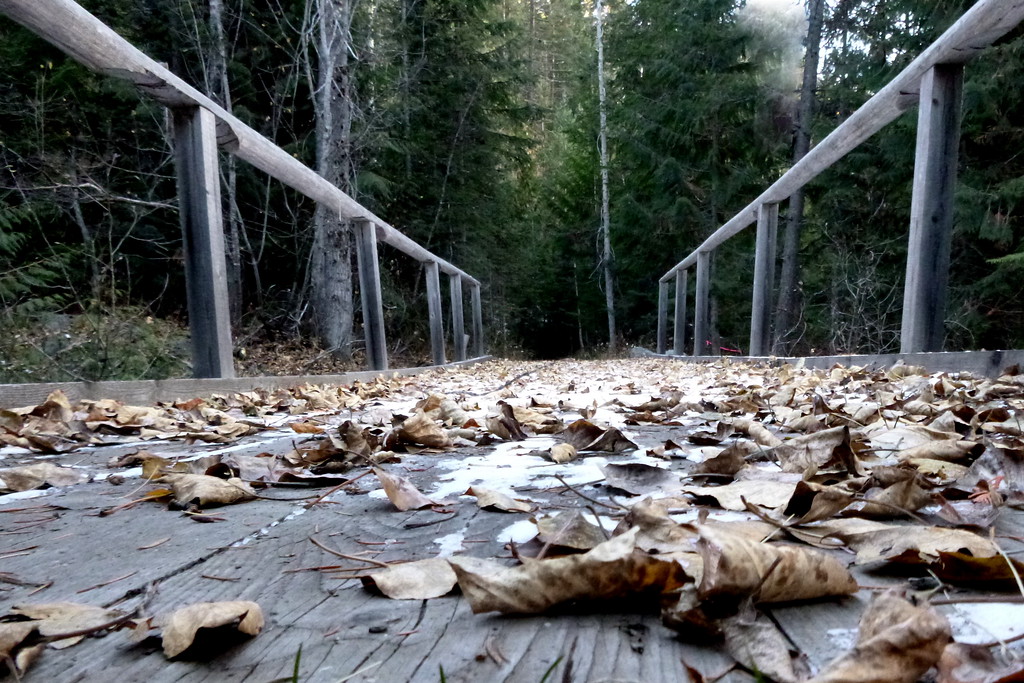
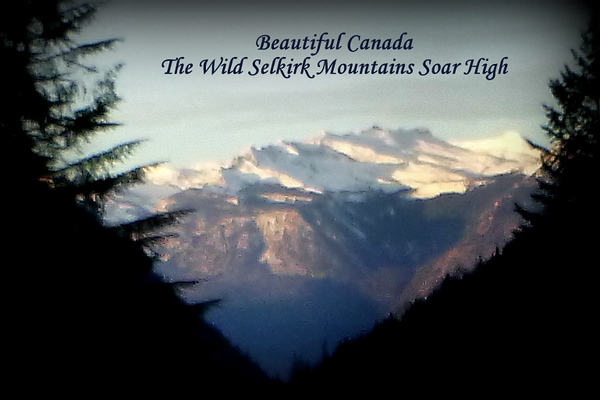
Kaslo, BC
With its population of around 1000 people, Kaslo is a charming town that traces its roots back to 1892 when it was established to cater to the gold and silver-mining boom in the region During that time the town grew to about 5000 people. I was surprised to discover, that in 1942, Kaslo was also utilized to intern Japanese Canadians.
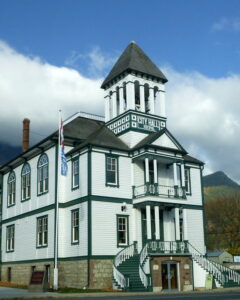 Today, Kaslo has transformed into a lively and cheerful town. Situated on the shores of Kootenay Lake, it has become a popular tourist destination. The town’s appeal lies in its rich history and culture, drawing people to explore and experience its unique charm. With it being after tourist season the tourist attractions weren’t open but it was still nice to drive around to see the wonderful buildings and admire the architecture.
Today, Kaslo has transformed into a lively and cheerful town. Situated on the shores of Kootenay Lake, it has become a popular tourist destination. The town’s appeal lies in its rich history and culture, drawing people to explore and experience its unique charm. With it being after tourist season the tourist attractions weren’t open but it was still nice to drive around to see the wonderful buildings and admire the architecture.
Kaslo Municipal Hall
Built in 1898 the Municipal Hall was placed on the designated national historic site of Canada as the oldest remaining town hall on the British Columbia mainland.
SS Moyie
When I spotted the brilliant white sternwheeler on the shores of Kootenay Lake, it triggered a flood of memories from the early 1980s. Back during a motorcycle campout at Mirror Lake, our group took a ride into Kaslo, where a few of us explored the SS Moyie.
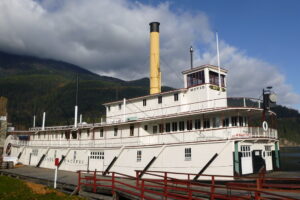 Sailboats and sternwheelers had always fascinated me and this was the first one I had the pleasure of boarding one. However, the sternwheeler now remains docked in a concrete berth by the lake, no longer sailing. In retrospect, it’s a good thing I didn’t have the chance to sail on it, as I’ve discovered that I easily get seasick.
Sailboats and sternwheelers had always fascinated me and this was the first one I had the pleasure of boarding one. However, the sternwheeler now remains docked in a concrete berth by the lake, no longer sailing. In retrospect, it’s a good thing I didn’t have the chance to sail on it, as I’ve discovered that I easily get seasick.
The SS Moyie is the oldest intact paddle steamer sternwheeler boat in the world. It was built in Nelson, BC and launched in 1898 and catered to passenger with it elaborately decorated interior. The SS Moyie made it’s last run in 1957. Not wanting the Sternwheeler to vanish it was purchased by the Kootenay Lake Historical Society from CPR for $1 and restored to 1898 standards.
Designated a National Historic Site of Canada in 1958, added to the BC Register of Historic Places, and is now a museum.
Even though it was closed, the memories returning from all those years ago made me happy. Little did I know more memories would come back as we continued toward home.
We hit the road again, tracing the Eastern Shore of Kootenai Lake on Hwy 31. Passing by Mirror Lake brought back memories of camping with my motorcycle club in the 1980s. I could vividly picture cruising on my ’77 Yamaha XS750 along this route, and recalling those days always brings me joy.
Further along, Ainsworth Hot Springs came into view—a spot we explored during that club campout. I thought about the happy faces from years ago as we enjoyed the pools, especially the horseshoe-shaped cave where the hot water originates. The cave is lit so you can walk through and it turns into a natural steam bath as you walk toward the back, with the water getting hotter. The main pool offered a perfect balance for lounging, chatting with friends, and even some swimming. There was a sectioned-off area for hot water and another pool for a cold plunge.
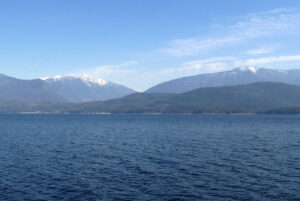 While Ainsworth has undergone renovations and expansions over the years, the mineral water remains unchanged and doesn’t have an odor. Another thing that hasn’t changed is the beautiful view from the pool of Kootenay Lake. Nowadays, there’s a restaurant and hotel which wasn’t available back in the day.
While Ainsworth has undergone renovations and expansions over the years, the mineral water remains unchanged and doesn’t have an odor. Another thing that hasn’t changed is the beautiful view from the pool of Kootenay Lake. Nowadays, there’s a restaurant and hotel which wasn’t available back in the day.
Considering my sister’s disinterest in swimming or soaking in hot pools, Ainsworth wasn’t on the agenda this time. I’m uncertain if I’ll ever visit again, but the wonderful memories from my previous trips linger on.
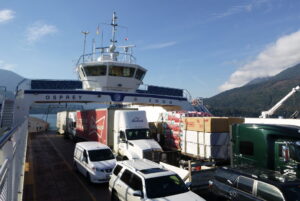 Before we knew it, we reached Balfour, BC, at the Kootenay Lake Ferry Terminal. The wait was brief, and we soon found ourselves boarding the ferry. Given that my sister had never experienced a ferry ride, it was understandable that she felt a bit nervous. To ease into the journey, we headed to the cafeteria
Before we knew it, we reached Balfour, BC, at the Kootenay Lake Ferry Terminal. The wait was brief, and we soon found ourselves boarding the ferry. Given that my sister had never experienced a ferry ride, it was understandable that she felt a bit nervous. To ease into the journey, we headed to the cafeteria 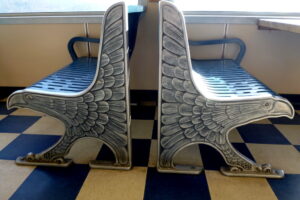 and grabbed some coffee to savor during the lake crossing.
and grabbed some coffee to savor during the lake crossing.
As soon as the ferry set in motion, my sister’s initial nervousness began to fade, and she started enjoying the ride along with the picturesque views. The cafeteria’s booths and walls adorned with eagle decorations added to the experience, providing a pleasant atmosphere that I, too, appreciated.



As we headed south on BC-3A towards home, I spotted the sign for North Woven Broom. Making a spontaneous decision, I swiftly turned into the parking area. This unique shop dedicated to crafting brooms was one of the highlights of our adventure.
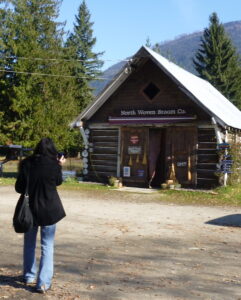 Approaching the quaint log barn with a heavy wool blanket draped over the entrance, there was an air of curiosity. Initially uncertain about what awaited inside, lifting the blanket felt like a journey back in time.
Approaching the quaint log barn with a heavy wool blanket draped over the entrance, there was an air of curiosity. Initially uncertain about what awaited inside, lifting the blanket felt like a journey back in time.
Luke Lewis and his sister Janet greeted us warmly as we entered the shop. The visit turned out to be both informative and enjoyable, as they walked us through the process of crafting their exquisite brooms. The beauty of their creations was in the traditional methods employed, using antique equipment.
Established in 1975 within the small barn on their family farm, the business, now owned by Luke, receives occasional assistance from his sister Janet. We were fortunate to find both of them present and willing to spend time with us.
Their brooms have gained recognition as props in numerous TV shows, stage plays, and movies. Notably, the Harry Potter series ordered 800 brooms in various sizes, and their brooms were featured in the Bewitched Movie, with the prototype proudly displayed in the shop.
During my time in Canada, I was keeping a lookout for a unique memento for my sister’s first visit. Unable to find anything suitable and wanting more than a typical tourist souvenir, I discovered the perfect item—a handcrafted broom. One of these special brooms found its way home with her, and she treasures it, guarding it closely. It warms my heart to see how much she values this unique reminder of her visit.
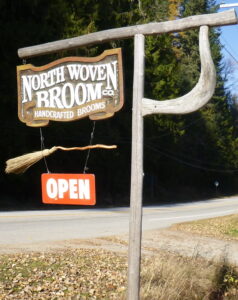

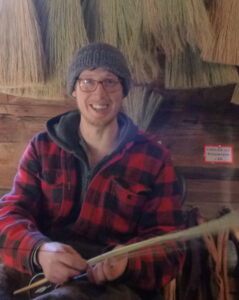


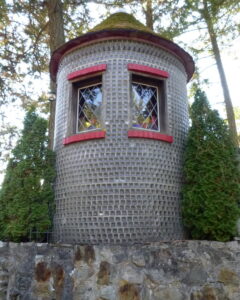
Following our visit to North Woven Brooms, there was another place ahead that I was excited to show my sister—an extraordinary glass house that I thought she would find fascinating. Unfortunately, much like the previous tourist site, it wasn’t open. We managed to catch a glimpse of the exterior but couldn’t explore the grounds or go inside.
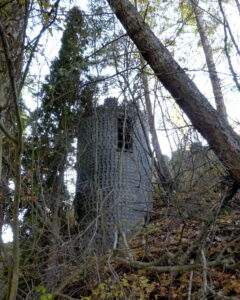 In 1952 David H. Brown was before his time when it came to recycling. He spent 35 years in the funeral business and thought there should be a use for all the discarded embalming fluid bottles. After Mr. Brown retired he got busy collecting bottles from funeral homes and built the castle like house and grounds out of 500,000 empty embalming fluid bottles.
In 1952 David H. Brown was before his time when it came to recycling. He spent 35 years in the funeral business and thought there should be a use for all the discarded embalming fluid bottles. After Mr. Brown retired he got busy collecting bottles from funeral homes and built the castle like house and grounds out of 500,000 empty embalming fluid bottles.
This location also brought memories forward, this time back to 1972. My husband, at the time, took me there to see the glass house. At first, I thought it was creepy to build a house out of those bottles, and then I thought it was creative. We had a lot of fun during that little adventure.
After seeing what we could see at the Glass House we headed home. We crossed the border back into the United States at Porthill, ID.


